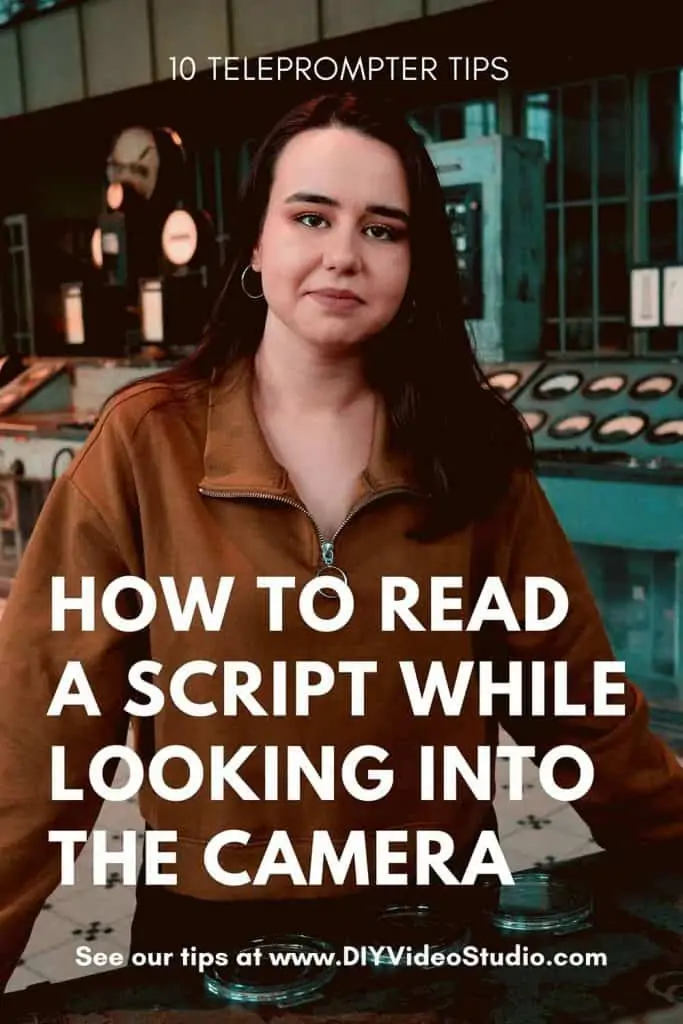DIY Video Studio is supported by its readers. Please assume links on this site are affiliate links or ads, and that I get commissions for purchases made through these links. As an Amazon Associate, I earn from qualifying purchases. Thank you if you use any of the links.
Many people beginning their YouTube journey think that new and expensive video gear will make them look like a YouTube pro. Unfortunately, they’re often disappointed.
Getting a teleprompter is a typical example. It’s easy to convince yourself that a teleprompter will help transform your delivery and add a professional polish to your delivery to the camera.
The one thing you need most is to put in the time and practice. Without practice, even the most expensive professional equipment will only make your inexperience appear clearer.

The one most important thing you need to sound like the pros is practice.
Practice will allow you to relax and be confident when reading a script from a teleprompter. Appearing natural in your delivery will help you engage with the viewer, making your presentation more compelling to watch and keeping your audience watching for longer.
You should look and sound as if you’re speaking directly to your viewer. Yes, imagine you’re speaking to one individual rather than an audience of many thousands. Most importantly, you should be speaking, as if you’re having a conversation, and not obviously reading from a script.
Make sure you sound like you’re speaking and not reading
OK. I think I’ve convinced you that you need to practice, but what are the things you need to practice?
Let’s get into the teleprompter tips and learn how to make your teleprompter reading appear natural while looking into the camera. You’ll then be able to up your game in front of the camera.
Teleprompter reading tips for YouTubers

TIP #1: Read your script aloud before recording
I’ve spent forty years writing broadcast scripts and the one thing I’ve learned is that writing for the spoken word is completely different from writing for the written page.
What looks good written down can sound awkward and be difficult to read. When speaking it’s natural to use informal language but we tend to write more formally. The trouble is that we have been taught to write that way at school and college when authoring essays and reports, and that style of writing has become a habit.
To combat that ingrained formal writing style read your script aloud. You’ll instantly hear when you’re not speaking informally. You’ll also trip yourself up if you’ve written your script using long and complicated words and sentences.
Reading aloud will give you the opportunity to tweak the script, making any necessary changes so it sounds much more like the way you speak. That’s important because if the script is written in the way you speak, your delivery will sound much more natural because you’ll find it easier to read.
TIP #2: Use the same language you normally do when speaking
Don’t fill your script with fancy words to try and make yourself sound clever. Use the kind of language you’d normally use when speaking off-the-cuff to your audience.
If you didn’t write the script, you should try and make it your own by making a few changes to try and make it more conversational. However, make sure you’re not changing the meaning of what’s in the script.
TIP #3: Review the script before recording
You should be familiar with the copy before stepping in front of the camera. I don’t mean that you should try memorizing the script line for line, which would negate the purpose of having a teleprompter. Review the script so you’ll know what is coming up and so you can be comfortable with any unusual words that may crop up, that way they don’t trip you up.
So, make sure you review the script and get familiar with the copy before hitting the record button on your camera.
Tip #4: Make the script sound interesting
When reading from the teleprompter you need to add interest to the way you speak. Use inflection in your voice. Stress important words. Vary the pace as you proceed. And add a little punch to the end of a phrase to indicate the end of a sentence.
Whatever you do, don’t read your script so that it sounds monotone or is mechanical in its rhythm.
Tip #5. Don’t be afraid of silence
When I started out in broadcasting, I remember how I and many of my friends were terrified of silence. If there was silence, we felt we had to fill it, even if that meant making some inane comments. Fortunately, we quickly learned that using silence can be as effective as speaking. In fact, adding a pause after making a statement could draw attention to what had been said.
So, use silence if it’s warranted. It can make what you say sound more interesting and make you sound thoughtful.
Tip #6: It’s OK to record in chunks
Although some YouTubers can effortlessly speak from start to finish, most of us can’t.
Next time you watch a YouTube video watch out for cuts where the scale of the YouTuber changes, b-roll footage is shown or the video cuts to another camera. I’ll guarantee that most of those edits happened to cover up a jump cut because the editor cut between different takes recorded by the presenter.
That’s not a failing, it’s quite normal. So, if you can’t record the whole script in one go, don’t work. Relax and record in chunks or sections.
If you stumble, that OK. Go back a sentence or two and record again. After editing the ordinary viewer won’t know you made a mistake.
Tip #7: Remember, you’re in control
If you’re lucky enough to have a teleprompter operator they will adjust the teleprompter scroll speed to match your pace. But if you’re working on your own you don’t have to be at the mercy of a teleprompter app that will keep on scrolling regardless of where you are in the script.
Most good teleprompter apps offer a remote-control feature. Depending on your control device this may include start/stop, scroll speed adjustment, and a few other functions.
A common remote control is a Bluetooth games controller where the various buttons can be mapped to control whatever you want.
So, don’t get panicked by text scrolling off the top of the screen or having to wait while the script catches up with you. Control the teleprompter remotely so you can comfortably deliver your best performance.
TIP #8: Smile and appear approachable
Unless your video is about something serious and somber try smiling and try and have fun while creating video content. The fact that your smile has a positive effect on making you feel more relaxed.
Smiling also has a positive effect on your audience. If they see you smiling, they’ll see you as approachable and will warm to you.
So, smile and look as if you want to be in front of the camera. Your viewers will respond more positively toward you.
Tip #8: Maintain eye contact with the viewer
When you’re having a conversation with someone you’ve just met you won’t dream of looking around the room and avoiding eye contact while chatting. Doing so would be considered rude and I’m sure the conversation would soon be cut short.
There’s no real difference in your video. You need to keep looking into the lens of the camera, or at least give the impression that you are. That’s where your viewer is. Maintaining eye contact with the viewer will help you engage with them.
However, don’t overdo it. Don’t look creepy and remember to blink. The idea is to look friendly, natural, and engaging.
Tip #9: Use an easy-to-read font and large font size
There are countless fonts that you can choose for your script but choosing the wrong one can make you stumble.
You should choose a font that is easy on the eye so it’s easy to read.
Choosing a good font can help you read the script without tripping over the wording. My preferred fonts are Arial or Calibri.
Tip #10: Release your inner extrovert
The way you hear yourself in your head is frequently quite different from the way others hear us. Although you may think you sound quite exuberant in your speech when you hear a recording played back you discover your delivery was much flatter than you had thought.
To keep the attention and interest of the viewer you need to sound enthusiastic, so push yourself to sound larger than life, at least in your own head. So don’t worry if you think you are sounding too lively during your performance. On playback, you’re likely to sound simply fine.
Summary
Those are ten teleprompter tips you should learn and put into practice if you want to improve your teleprompter reading techniques. Your YouTube videos will be all the better for them.
Although you should know all ten tips, you might want to implement them one at a time. Otherwise, you may feel overwhelmed and give up, which would be a shame.
You might also like…
- How to read a teleprompter without moving your eyes
- Do YouTubers use teleprompters for their videos?
- How do you read a script naturally from a teleprompter?
- Can you use your phone as a teleprompter? Best products and Apps
- Alternatives to Teleprompters for YouTube Videos
- What is a teleprompter and how it works?
Tosh Lubek runs an audio and video production business in the UK and has been using the Canon EOS R since it was released in the Autumn of 2018 and the Canon EOS R6 in 2020. He has used both cameras to shoot TV commercials broadcast on Sky TV, promotional business videos, videos of events and functions, and YouTube creator content. He has also won several international awards for his advertising and promotional work. You can meet him by visiting his “video booth” at HashTag Business Events across the country.
Recent Posts
You're Using the Canon RF 50mm f/1.8 WRONG! Here’s How to Fix It
If you’ve recently picked up the Canon RF 50mm f/1.8 STM—affectionately known as the Nifty Fifty—you might be confused by that strange switch on the side of the lens. It doesn’t say AF/MF...
Recently, I shot several customer testimonial videos in 4K for a client when the overheating warning on my Canon EOS R6 appeared. In fact, it appeared three times in five sessions during the day of...



